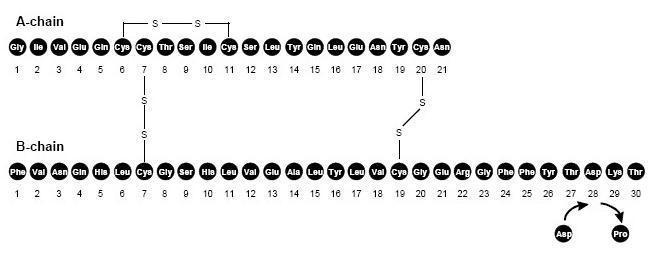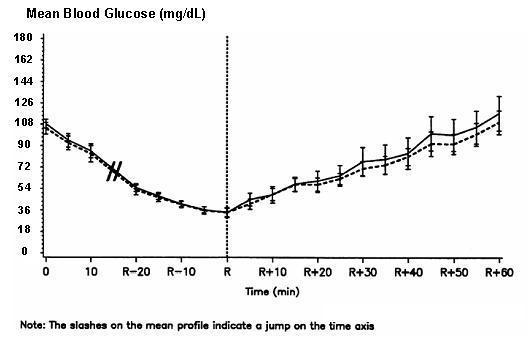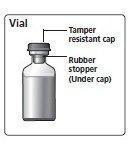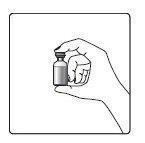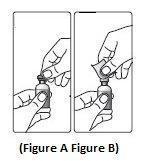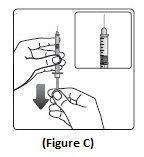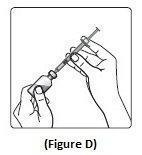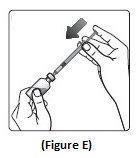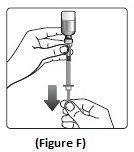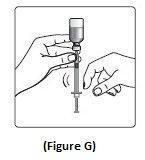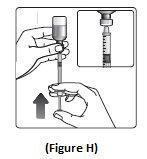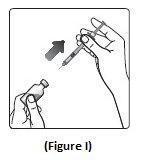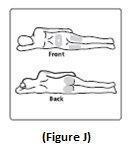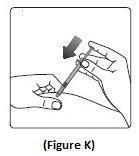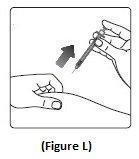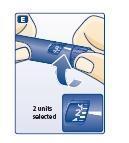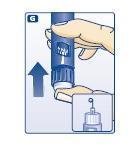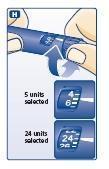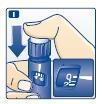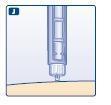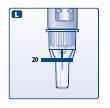NOVOLOG- insulin aspart injection, solution
NovoLog by
Drug Labeling and Warnings
NovoLog by is a Prescription medication manufactured, distributed, or labeled by Dispensing Solutions, Inc., PSS World Medical, Inc.. Drug facts, warnings, and ingredients follow.
Drug Details [pdf]
-
HIGHLIGHTS OF PRESCRIBING INFORMATION
These highlights do not include all the information needed to use NovoLog safely and effectively.
See full prescribing information for NovoLog.
NovoLog® (insulin aspart [rDNA origin] injection) solution for subcutaneous use
Initial U.S. Approval: 2000RECENT MAJOR CHANGES
- Warnings and Precautions (5.10) 3/2013
INDICATIONS AND USAGE
- NovoLog is an insulin analog indicated to improve glycemic control in adults and children with diabetes mellitus (1.1).
DOSAGE AND ADMINISTRATION
- The dosage of NovoLog must be individualized.
- Subcutaneous injection: NovoLog should generally be given immediately (within 5-10 minutes) prior to the start of a meal (2.2).
- Use in pumps: Change the NovoLog in the reservoir at least every 6 days, change the infusion set, and the infusion set insertion site at least every 3 days. NovoLog should not be mixed with other insulins or with a diluent when it is used in the pump (2.3).
- Intravenous use: NovoLog should be used at concentrations from 0.05 U/mL to 1.0 U/mL insulin aspart in infusion systems using polypropylene infusion bags. NovoLog has been shown to be stable in infusion fluids such as 0.9% sodium chloride (2.4).
DOSAGE FORMS AND STRENGTHS
CONTRAINDICATIONS
- Do not use during episodes of hypoglycemia (4).
- Do not use in patients with hypersensitivity to NovoLog or one of its excipients.
WARNINGS AND PRECAUTIONS
- Hypoglycemia is the most common adverse effect of insulin therapy. Glucose monitoring is recommended for all patients with diabetes. Any change of insulin dose should be made cautiously and only under medical supervision (5.1, 5.2).
- Insulin, particularly when given intravenously or in settings of poor glycemic control, can cause hypokalemia. Use caution in patients predisposed to hypokalemia (5.3).
- Like all insulins, NovoLog requirements may be reduced in patients with renal impairment or hepatic impairment (5.4, 5.5).
- Severe, life-threatening, generalized allergy, including anaphylaxis, may occur with insulin products, including NovoLog (5.6).
- Fluid retention and heart failure can occur with concomitant use of thiazolidinediones (TZDs), which are PPAR-gamma agonists, and insulin, including NovoLog (5.10).
ADVERSE REACTIONS
Adverse reactions observed with NovoLog include hypoglycemia, allergic reactions, local injection site reactions, lipodystrophy, rash and pruritus (6).
To report SUSPECTED ADVERSE REACTIONS, contact Novo Nordisk Inc. at 1-800-727-6500 or FDA at 1-800-FDA-1088 or www.fda.gov/medwatch.
DRUG INTERACTIONS
- The following may increase the blood-glucose-lowering effect and susceptibility to hypoglycemia: oral antidiabetic products, pramlintide, ACE inhibitors, disopyramide, fibrates, fluoxetine, monoamine oxidase inhibitors, propoxyphene, salicylates, somatostatin analogs, sulfonamide antibiotics (7).
- The following may reduce the blood-glucose-lowering effect: corticosteroids, niacin, danazol, diuretics, sympathomimetic agents (e.g., epinephrine, salbutamol, terbutaline), isoniazid, phenothiazine derivatives, somatropin, thyroid hormones, estrogens, progestogens (e.g., in oral contraceptives), atypical antipsychotics (7).
- Beta-blockers, clonidine, lithium salts, and alcohol may either potentiate or weaken the blood-glucose-lowering effect of insulin (7).
- Pentamidine may cause hypoglycemia, which may sometimes be followed by hyperglycemia (7).
- The signs of hypoglycemia may be reduced or absent in patients taking sympatholytic products such as beta-blockers, clonidine, guanethidine, and reserpine (7).
USE IN SPECIFIC POPULATIONS
- Pediatric: Has not been studied in children with type 2 diabetes. Has not been studied in children with type 1 diabetes <2 years of age (8.4).
See 17 for PATIENT COUNSELING INFORMATION and FDA-approved patient labeling.
Revised: 3/2013
-
Table of Contents
FULL PRESCRIBING INFORMATION: CONTENTS*
1 INDICATIONS AND USAGE
1.1 Treatment of Diabetes Mellitus
2 DOSAGE AND ADMINISTRATION
2.1 Dosing
2.2 Subcutaneous Injection
2.3 Continuous Subcutaneous Insulin Infusion (CSII) by External Pump
2.4 Intravenous Use
3 DOSAGE FORMS AND STRENGTHS
4 CONTRAINDICATIONS
5 WARNINGS AND PRECAUTIONS
5.1 Administration
5.2 Hypoglycemia
5.3 Hypokalemia
5.4 Renal Impairment
5.5 Hepatic Impairment
5.6 Hypersensitivity and Allergic Reactions
5.7 Antibody Production
5.8 Mixing of Insulins
5.9 Continuous Subcutaneous Insulin Infusion by External Pump
5.10 Fluid retention and heart failure with concomitant use of PPAR-gamma agonists
6 ADVERSE REACTIONS
7 DRUG INTERACTIONS
8 USE IN SPECIFIC POPULATIONS
8.1 Pregnancy
8.3 Nursing Mothers
8.4 Pediatric Use
8.5 Geriatric Use
10 OVERDOSAGE
11 DESCRIPTION
12 CLINICAL PHARMACOLOGY
12.1 Mechanism of Action
12.2 Pharmacodynamics
12.3 Pharmacokinetics
13 NONCLINICAL TOXICOLOGY
13.1 Carcinogenesis, Mutagenesis, Impairment of Fertility
13.2 Animal Toxicology and/or Pharmacology
14 CLINICAL STUDIES
14.1 Subcutaneous Daily Injections
14.2 Continuous Subcutaneous Insulin Infusion (CSII) by External Pump
14.3 Intravenous Administration of NovoLog
16 HOW SUPPLIED/STORAGE AND HANDLING
16.1 How Supplied
16.2 Recommended Storage
17 PATIENT COUNSELING INFORMATION
17.1 Physician Instructions
17.2 Patients Using Pumps
17.3 FDA-Approved Patient Labeling
- * Sections or subsections omitted from the full prescribing information are not listed.
- 1 INDICATIONS AND USAGE
-
2 DOSAGE AND ADMINISTRATION
2.1 Dosing
NovoLog is an insulin analog with an earlier onset of action than regular human insulin. The dosage of NovoLog must be individualized. NovoLog given by subcutaneous injection should generally be used in regimens with an intermediate or long-acting insulin [see Warnings and Precautions (5), How Supplied/Storage and Handling (16.2)]. The total daily insulin requirement may vary and is usually between 0.5 to 1.0 units/kg/day. When used in a meal-related subcutaneous injection treatment regimen, 50 to 70% of total insulin requirements may be provided by NovoLog and the remainder provided by an intermediate-acting or long-acting insulin. Because of NovoLog’s comparatively rapid onset and short duration of glucose lowering activity, some patients may require more basal insulin and more total insulin to prevent pre-meal hyperglycemia when using NovoLog than when using human regular insulin.
Do not use NovoLog that is viscous (thickened) or cloudy; use only if it is clear and colorless. NovoLog should not be used after the printed expiration date.
2.2 Subcutaneous Injection
NovoLog should be administered by subcutaneous injection in the abdominal region, buttocks, thigh, or upper arm. Because NovoLog has a more rapid onset and a shorter duration of activity than human regular insulin, it should be injected immediately (within 5-10 minutes) before a meal. Injection sites should be rotated within the same region to reduce the risk of lipodystrophy. As with all insulins, the duration of action of NovoLog will vary according to the dose, injection site, blood flow, temperature, and level of physical activity.
NovoLog may be diluted with Insulin Diluting Medium for NovoLog for subcutaneous injection. Diluting one part NovoLog to nine parts diluent will yield a concentration one-tenth that of NovoLog (equivalent to U-10). Diluting one part NovoLog to one part diluent will yield a concentration one-half that of NovoLog (equivalent to U-50).
2.3 Continuous Subcutaneous Insulin Infusion (CSII) by External Pump
NovoLog can also be infused subcutaneously by an external insulin pump [see Warnings and Precautions (5.8, 5.9), How Supplied/Storage and Handling (16.2)]. Diluted insulin should not be used in external insulin pumps. Because NovoLog has a more rapid onset and a shorter duration of activity than human regular insulin, pre-meal boluses of NovoLog should be infused immediately (within 5-10 minutes) before a meal. Infusion sites should be rotated within the same region to reduce the risk of lipodystrophy. The initial programming of the external insulin infusion pump should be based on the total daily insulin dose of the previous regimen. Although there is significant interpatient variability, approximately 50% of the total dose is usually given as meal-related boluses of NovoLog and the remainder is given as a basal infusion. Change the NovoLog in the reservoir at least every 6 days, change the infusion sets and the infusion set insertion site at least every 3 days.
The following insulin pumps† have been used in NovoLog clinical or in vitro studies conducted by Novo Nordisk, the manufacturer of NovoLog:
- Medtronic Paradigm® 512 and 712
- MiniMed 508
- Disetronic® D-TRON® and H-TRON®
Before using a different insulin pump with NovoLog, read the pump label to make sure the pump has been evaluated with NovoLog.
2.4 Intravenous Use
NovoLog can be administered intravenously under medical supervision for glycemic control with close monitoring of blood glucose and potassium levels to avoid hypoglycemia and hypokalemia [see Warnings and Precautions (5), How Supplied/Storage and Handling (16.2)]. For intravenous use, NovoLog should be used at concentrations from 0.05 U/mL to 1.0 U/mL insulin aspart in infusion systems using polypropylene infusion bags. NovoLog has been shown to be stable in infusion fluids such as 0.9% sodium chloride.
Inspect NovoLog for particulate matter and discoloration prior to parenteral administration.
-
3 DOSAGE FORMS AND STRENGTHS
NovoLog is available in the following package sizes: each presentation contains 100 units of insulin aspart per mL (U-100).
- 10 mL vials
- 3 mL PenFill cartridges for the 3 mL PenFill cartridge delivery device (with or without the addition of a NovoPen® 3 PenMate®) with NovoFine® disposable needles
- 3 mL NovoLog FlexPen
- 4 CONTRAINDICATIONS
-
5 WARNINGS AND PRECAUTIONS
5.1 Administration
NovoLog has a more rapid onset of action and a shorter duration of activity than regular human insulin. An injection of NovoLog should immediately be followed by a meal within 5-10 minutes. Because of NovoLog’s short duration of action, a longer acting insulin should also be used in patients with type 1 diabetes and may also be needed in patients with type 2 diabetes. Glucose monitoring is recommended for all patients with diabetes and is particularly important for patients using external pump infusion therapy.
Any change of insulin dose should be made cautiously and only under medical supervision. Changing from one insulin product to another or changing the insulin strength may result in the need for a change in dosage. As with all insulin preparations, the time course of NovoLog action may vary in different individuals or at different times in the same individual and is dependent on many conditions, including the site of injection, local blood supply, temperature, and physical activity. Patients who change their level of physical activity or meal plan may require adjustment of insulin dosages. Insulin requirements may be altered during illness, emotional disturbances, or other stresses.
Patients using continuous subcutaneous insulin infusion pump therapy must be trained to administer insulin by injection and have alternate insulin therapy available in case of pump failure.
Needles and NovoLog FlexPen must not be shared.
5.2 Hypoglycemia
Hypoglycemia is the most common adverse effect of all insulin therapies, including NovoLog. Severe hypoglycemia may lead to unconsciousness and/or convulsions and may result in temporary or permanent impairment of brain function or death. Severe hypoglycemia requiring the assistance of another person and/or parenteral glucose infusion or glucagon administration has been observed in clinical trials with insulin, including trials with NovoLog.
The timing of hypoglycemia usually reflects the time-action profile of the administered insulin formulations [see Clinical Pharmacology (12)]. Other factors such as changes in food intake (e.g., amount of food or timing of meals), injection site, exercise, and concomitant medications may also alter the risk of hypoglycemia [see Drug Interactions (7)]. As with all insulins, use caution in patients with hypoglycemia unawareness and in patients who may be predisposed to hypoglycemia (e.g., patients who are fasting or have erratic food intake). The patient’s ability to concentrate and react may be impaired as a result of hypoglycemia. This may present a risk in situations where these abilities are especially important, such as driving or operating other machinery.
Rapid changes in serum glucose levels may induce symptoms of hypoglycemia in persons with diabetes, regardless of the glucose value. Early warning symptoms of hypoglycemia may be different or less pronounced under certain conditions, such as longstanding diabetes, diabetic nerve disease, use of medications such as beta-blockers, or intensified diabetes control [see Drug Interactions (7)]. These situations may result in severe hypoglycemia (and, possibly, loss of consciousness) prior to the patient’s awareness of hypoglycemia. Intravenously administered insulin has a more rapid onset of action than subcutaneously administered insulin, requiring more close monitoring for hypoglycemia.
5.3 Hypokalemia
All insulin products, including NovoLog, cause a shift in potassium from the extracellular to intracellular space, possibly leading to hypokalemia that, if left untreated, may cause respiratory paralysis, ventricular arrhythmia, and death. Use caution in patients who may be at risk for hypokalemia (e.g., patients using potassium-lowering medications, patients taking medications sensitive to serum potassium concentrations, and patients receiving intravenously administered insulin).
5.4 Renal Impairment
As with other insulins, the dose requirements for NovoLog may be reduced in patients with renal impairment [see Clinical Pharmacology (12.3)].
5.5 Hepatic Impairment
As with other insulins, the dose requirements for NovoLog may be reduced in patients with hepatic impairment [see Clinical Pharmacology (12.3)].
5.6 Hypersensitivity and Allergic Reactions
Local Reactions - As with other insulin therapy, patients may experience redness, swelling, or itching at the site of NovoLog injection. These reactions usually resolve in a few days to a few weeks, but in some occasions, may require discontinuation of NovoLog. In some instances, these reactions may be related to factors other than insulin, such as irritants in a skin cleansing agent or poor injection technique. Localized reactions and generalized myalgias have been reported with injected metacresol, which is an excipient in NovoLog.
Systemic Reactions - Severe, life-threatening, generalized allergy, including anaphylaxis, may occur with any insulin product, including NovoLog. Anaphylactic reactions with NovoLog have been reported post-approval. Generalized allergy to insulin may also cause whole body rash (including pruritus), dyspnea, wheezing, hypotension, tachycardia, or diaphoresis. In controlled clinical trials, allergic reactions were reported in 3 of 735 patients (0.4%) treated with regular human insulin and 10 of 1394 patients (0.7%) treated with NovoLog. In controlled and uncontrolled clinical trials, 3 of 2341 (0.1%) NovoLog-treated patients discontinued due to allergic reactions.
5.7 Antibody Production
Increases in anti-insulin antibody titers that react with both human insulin and insulin aspart have been observed in patients treated with NovoLog. Increases in anti-insulin antibodies are observed more frequently with NovoLog than with regular human insulin. Data from a 12-month controlled trial in patients with type 1 diabetes suggest that the increase in these antibodies is transient, and the differences in antibody levels between the regular human insulin and insulin aspart treatment groups observed at 3 and 6 months were no longer evident at 12 months. The clinical significance of these antibodies is not known. These antibodies do not appear to cause deterioration in glycemic control or necessitate increases in insulin dose.
5.8 Mixing of Insulins
- Mixing NovoLog with NPH human insulin immediately before injection attenuates the peak concentration of NovoLog, without significantly affecting the time to peak concentration or total bioavailability of NovoLog. If NovoLog is mixed with NPH human insulin, NovoLog should be drawn into the syringe first, and the mixture should be injected immediately after mixing.
- The efficacy and safety of mixing NovoLog with insulin preparations produced by other manufacturers have not been studied.
- Insulin mixtures should not be administered intravenously.
5.9 Continuous Subcutaneous Insulin Infusion by External Pump
When used in an external subcutaneous insulin infusion pump, NovoLog should not be mixed with any other insulin or diluent. When using NovoLog in an external insulin pump, the NovoLog-specific information should be followed (e.g., in-use time, frequency of changing infusion sets) because NovoLog-specific information may differ from general pump manual instructions.
Pump or infusion set malfunctions or insulin degradation can lead to a rapid onset of hyperglycemia and ketosis because of the small subcutaneous depot of insulin. This is especially pertinent for rapid-acting insulin analogs that are more rapidly absorbed through skin and have a shorter duration of action. Prompt identification and correction of the cause of hyperglycemia or ketosis is necessary. Interim therapy with subcutaneous injection may be required [see Dosage and Administration (2.3), Warnings and Precautions (5.8, 5.9), How Supplied/Storage and Handling (16.2), and Patient Counseling Information (17.2)].
NovoLog should not be exposed to temperatures greater than 37°C (98.6°F). NovoLog that will be used in a pump should not be mixed with other insulin or with a diluent [see Dosage and Administration (2.3), Warnings and Precautions (5.8, 5.9), How Supplied/Storage and Handling (16.2), and Patient Counseling Information (17.2)].
5.10 Fluid retention and heart failure with concomitant use of PPAR-gamma agonists
Thiazolidinediones (TZDs), which are peroxisome proliferator-activated receptor (PPAR)-gamma agonists, can cause dose-related fluid retention, particularly when used in combination with insulin. Fluid retention may lead to or exacerbate heart failure. Patients treated with insulin, including NovoLog, and a PPAR-gamma agonist should be observed for signs and symptoms of heart failure. If heart failure develops, it should be managed according to current standards of care, and discontinuation or dose reduction of the PPAR-gamma agonist must be considered.
-
6 ADVERSE REACTIONS
Clinical Trial Experience
Because clinical trials are conducted under widely varying designs, the adverse reaction rates reported in one clinical trial may not be easily compared to those rates reported in another clinical trial, and may not reflect the rates actually observed in clinical practice.
- Hypoglycemia
Hypoglycemia is the most commonly observed adverse reaction in patients using insulin, including NovoLog [see Warnings and Precautions (5)].
- Insulin initiation and glucose control intensification
Intensification or rapid improvement in glucose control has been associated with a transitory, reversible ophthalmologic refraction disorder, worsening of diabetic retinopathy, and acute painful peripheral neuropathy. However, long-term glycemic control decreases the risk of diabetic retinopathy and neuropathy.
- Lipodystrophy
Long-term use of insulin, including NovoLog, can cause lipodystrophy at the site of repeated insulin injections or infusion. Lipodystrophy includes lipohypertrophy (thickening of adipose tissue) and lipoatrophy (thinning of adipose tissue), and may affect insulin absorption. Rotate insulin injection or infusion sites within the same region to reduce the risk of lipodystrophy.
- Weight gain
Weight gain can occur with some insulin therapies, including NovoLog, and has been attributed to the anabolic effects of insulin and the decrease in glucosuria.
- Peripheral Edema
Insulin may cause sodium retention and edema, particularly if previously poor metabolic control is improved by intensified insulin therapy.
- Frequencies of adverse drug reactions
The frequencies of adverse drug reactions during NovoLog clinical trials in patients with type 1 diabetes mellitus and type 2 diabetes mellitus are listed in the tables below.
Table 1: Treatment-Emergent Adverse Events in Patients with Type 1 Diabetes Mellitus (Adverse events with frequency ≥ 5% and occurring more frequently with NovoLog compared to human regular insulin are listed) - * Hypoglycemia is defined as an episode of blood glucose concentration <45 mg/dL, with or without symptoms. See Section 14 for the incidence of serious hypoglycemia in the individual clinical trials.
NovoLog + NPH
N= 596
Human Regular Insulin + NPH
N= 286
Preferred Term
N
(%)
N
(%)
Hypoglycemia*
448
75%
205
72%
Headache
70
12%
28
10%
Injury accidental
65
11%
29
10%
Nausea
43
7%
13
5%
Diarrhea
28
5%
9
3%
Table 2: Treatment-Emergent Adverse Events in Patients with Type 2 Diabetes Mellitus (except for hypoglycemia, adverse events with frequency ≥ 5% and occurring more frequently with NovoLog compared to human regular insulin are listed) - * Hypoglycemia is defined as an episode of blood glucose concentration <45 mg/dL, with or without symptoms. See Section 14 for the incidence of serious hypoglycemia in the individual clinical trials.
NovoLog + NPH
N= 91
Human Regular Insulin + NPH
N= 91
N
(%)
N
(%)
Hypoglycemia*
25
27%
33
36%
Hyporeflexia
10
11%
6
7%
Onychomycosis
9
10%
5
5%
Sensory disturbance
8
9%
6
7%
Urinary tract infection
7
8%
6
7%
Chest pain
5
5%
3
3%
Headache
5
5%
3
3%
Skin disorder
5
5%
2
2%
Abdominal pain
5
5%
1
1%
Sinusitis
5
5%
1
1%
Postmarketing Data
The following additional adverse reactions have been identified during postapproval use of NovoLog. Because these adverse reactions are reported voluntarily from a population of uncertain size, it is generally not possible to reliably estimate their frequency. Medication errors in which other insulins have been accidentally substituted for NovoLog have been identified during postapproval use [see Patient Counseling Information (17)].
-
7 DRUG INTERACTIONS
A number of substances affect glucose metabolism and may require insulin dose adjustment and particularly close monitoring.
- The following are examples of substances that may increase the blood-glucose-lowering effect and susceptibility to hypoglycemia: oral antidiabetic products, pramlintide, ACE inhibitors, disopyramide, fibrates, fluoxetine, monoamine oxidase (MAO) inhibitors, propoxyphene, salicylates, somatostatin analog (e.g., octreotide), sulfonamide antibiotics.
- The following are examples of substances that may reduce the blood-glucose-lowering effect: corticosteroids, niacin, danazol, diuretics, sympathomimetic agents (e.g., epinephrine, salbutamol, terbutaline), isoniazid, phenothiazine derivatives, somatropin, thyroid hormones, estrogens, progestogens (e.g., in oral contraceptives), atypical antipsychotics.
- Beta-blockers, clonidine, lithium salts, and alcohol may either potentiate or weaken the blood-glucose-lowering effect of insulin.
- Pentamidine may cause hypoglycemia, which may sometimes be followed by hyperglycemia.
- The signs of hypoglycemia may be reduced or absent in patients taking sympatholytic products such as beta-blockers, clonidine, guanethidine, and reserpine.
-
8 USE IN SPECIFIC POPULATIONS
8.1 Pregnancy
Pregnancy Category B. All pregnancies have a background risk of birth defects, loss, or other adverse outcome regardless of drug exposure. This background risk is increased in pregnancies complicated by hyperglycemia and may be decreased with good metabolic control. It is essential for patients with diabetes or history of gestational diabetes to maintain good metabolic control before conception and throughout pregnancy. Insulin requirements may decrease during the first trimester, generally increase during the second and third trimesters, and rapidly decline after delivery. Careful monitoring of glucose control is essential in these patients. Therefore, female patients should be advised to tell their physician if they intend to become, or if they become pregnant while taking NovoLog.
An open-label, randomized study compared the safety and efficacy of NovoLog (n=157) versus regular human insulin (n=165) in 322 pregnant women with type 1 diabetes. Two-thirds of the enrolled patients were already pregnant when they entered the study. Because only one-third of the patients enrolled before conception, the study was not large enough to evaluate the risk of congenital malformations. Both groups achieved a mean HbA1c of ~ 6% during pregnancy, and there was no significant difference in the incidence of maternal hypoglycemia.
Subcutaneous reproduction and teratology studies have been performed with NovoLog and regular human insulin in rats and rabbits. In these studies, NovoLog was given to female rats before mating, during mating, and throughout pregnancy, and to rabbits during organogenesis. The effects of NovoLog did not differ from those observed with subcutaneous regular human insulin. NovoLog, like human insulin, caused pre- and post-implantation losses and visceral/skeletal abnormalities in rats at a dose of 200 U/kg/day (approximately 32 times the human subcutaneous dose of 1.0 U/kg/day, based on U/body surface area) and in rabbits at a dose of 10 U/kg/day (approximately three times the human subcutaneous dose of 1.0 U/kg/day, based on U/body surface area). The effects are probably secondary to maternal hypoglycemia at high doses. No significant effects were observed in rats at a dose of 50 U/kg/day and in rabbits at a dose of 3 U/kg/day. These doses are approximately 8 times the human subcutaneous dose of 1.0 U/kg/day for rats and equal to the human subcutaneous dose of 1.0 U/kg/day for rabbits, based on U/body surface area.
8.3 Nursing Mothers
It is unknown whether insulin aspart is excreted in human milk. Use of NovoLog is compatible with breastfeeding, but women with diabetes who are lactating may require adjustments of their insulin doses.
8.4 Pediatric Use
NovoLog is approved for use in children for subcutaneous daily injections and for subcutaneous continuous infusion by external insulin pump. NovoLog has not been studied in pediatric patients younger than 2 years of age. NovoLog has not been studied in pediatric patients with type 2 diabetes. Please see Section 14 CLINICAL STUDIES for summaries of clinical studies.
8.5 Geriatric Use
Of the total number of patients (n= 1,375) treated with NovoLog in 3 controlled clinical studies, 2.6% (n=36) were 65 years of age or over. One-half of these patients had type 1 diabetes (18/1285) and the other half had type 2 diabetes (18/90). The HbA1c response to NovoLog, as compared to human insulin, did not differ by age, particularly in patients with type 2 diabetes. Additional studies in larger populations of patients 65 years of age or over are needed to permit conclusions regarding the safety of NovoLog in elderly compared to younger patients. Pharmacokinetic/pharmacodynamic studies to assess the effect of age on the onset of NovoLog action have not been performed.
-
10 OVERDOSAGE
Excess insulin administration may cause hypoglycemia and, particularly when given intravenously, hypokalemia. Mild episodes of hypoglycemia usually can be treated with oral glucose. Adjustments in drug dosage, meal patterns, or exercise, may be needed. More severe episodes with coma, seizure, or neurologic impairment may be treated with intramuscular/subcutaneous glucagon or concentrated intravenous glucose. Sustained carbohydrate intake and observation may be necessary because hypoglycemia may recur after apparent clinical recovery. Hypokalemia must be corrected appropriately.
-
11 DESCRIPTION
NovoLog (insulin aspart [rDNA origin] injection) is a rapid-acting human insulin analog used to lower blood glucose. NovoLog is homologous with regular human insulin with the exception of a single substitution of the amino acid proline by aspartic acid in position B28, and is produced by recombinant DNA technology utilizing Saccharomyces cerevisiae (baker's yeast). Insulin aspart has the empirical formula C256H381N65079S6 and a molecular weight of 5825.8.
NovoLog is a sterile, aqueous, clear, and colorless solution, that contains insulin aspart 100 Units/mL, glycerin 16 mg/mL, phenol 1.50 mg/mL, metacresol 1.72 mg/mL, zinc 19.6 mcg/mL, disodium hydrogen phosphate dihydrate 1.25 mg/mL, sodium chloride 0.58 mg/mL and water for injection. NovoLog has a pH of 7.2-7.6. Hydrochloric acid 10% and/or sodium hydroxide 10% may be added to adjust pH.
-
12 CLINICAL PHARMACOLOGY
12.1 Mechanism of Action
The primary activity of NovoLog is the regulation of glucose metabolism. Insulins, including NovoLog, bind to the insulin receptors on muscle and fat cells and lower blood glucose by facilitating the cellular uptake of glucose and simultaneously inhibiting the output of glucose from the liver.
12.2 Pharmacodynamics
Studies in normal volunteers and patients with diabetes demonstrated that subcutaneous administration of NovoLog has a more rapid onset of action than regular human insulin.
In a study in patients with type 1 diabetes (n=22), the maximum glucose-lowering effect of NovoLog occurred between 1 and 3 hours after subcutaneous injection (see Figure 2). The duration of action for NovoLog is 3 to 5 hours. The time course of action of insulin and insulin analogs such as NovoLog may vary considerably in different individuals or within the same individual. The parameters of NovoLog activity (time of onset, peak time and duration) as designated in Figure 2 should be considered only as general guidelines. The rate of insulin absorption and onset of activity is affected by the site of injection, exercise, and other variables [see Warnings and Precautions (5.1)].
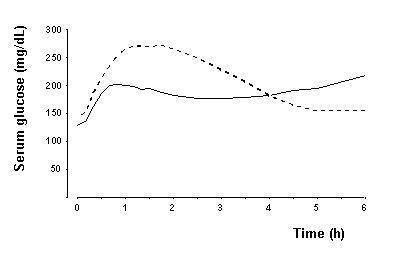
Figure 2. Serial mean serum glucose collected up to 6 hours following a single pre-meal dose of NovoLog (solid curve) or regular human insulin (hatched curve) injected immediately before a meal in 22 patients with type 1 diabetes.
A double-blind, randomized, two-way cross-over study in 16 patients with type 1 diabetes demonstrated that intravenous infusion of NovoLog resulted in a blood glucose profile that was similar to that after intravenous infusion with regular human insulin. NovoLog or human insulin was infused until the patient’s blood glucose decreased to 36 mg/dL, or until the patient demonstrated signs of hypoglycemia (rise in heart rate and onset of sweating), defined as the time of autonomic reaction (R) (see Figure 3).
12.3 Pharmacokinetics
The single substitution of the amino acid proline with aspartic acid at position B28 in NovoLog reduces the molecule's tendency to form hexamers as observed with regular human insulin. NovoLog is, therefore, more rapidly absorbed after subcutaneous injection compared to regular human insulin.
In a randomized, double-blind, crossover study 17 healthy Caucasian male subjects between 18 and 40 years of age received an intravenous infusion of either NovoLog or regular human insulin at 1.5 mU/kg/min for 120 minutes. The mean insulin clearance was similar for the two groups with mean values of 1.2 l/h/kg for the NovoLog group and 1.2 l/h/kg for the regular human insulin group.
Bioavailability and Absorption - NovoLog has a faster absorption, a faster onset of action, and a shorter duration of action than regular human insulin after subcutaneous injection (see Figure 2 and Figure 4). The relative bioavailability of NovoLog compared to regular human insulin indicates that the two insulins are absorbed to a similar extent.
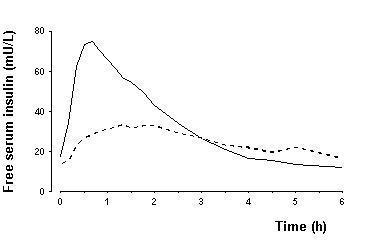
Figure 4. Serial mean serum free insulin concentration collected up to 6 hours following a single pre-meal dose of NovoLog (solid curve) or regular human insulin (hatched curve) injected immediately before a meal in 22 patients with type 1 diabetes.
In studies in healthy volunteers (total n=107) and patients with type 1 diabetes (total n=40), NovoLog consistently reached peak serum concentrations approximately twice as fast as regular human insulin. The median time to maximum concentration in these trials was 40 to 50 minutes for NovoLog versus 80 to 120 minutes for regular human insulin. In a clinical trial in patients with type 1 diabetes, NovoLog and regular human insulin, both administered subcutaneously at a dose of 0.15 U/kg body weight, reached mean maximum concentrations of 82 and 36 mU/L, respectively. Pharmacokinetic/pharmacodynamic characteristics of insulin aspart have not been established in patients with type 2 diabetes.
The intra-individual variability in time to maximum serum insulin concentration for healthy male volunteers was significantly less for NovoLog than for regular human insulin. The clinical significance of this observation has not been established.
In a clinical study in healthy non-obese subjects, the pharmacokinetic differences between NovoLog and regular human insulin described above, were observed independent of the site of injection (abdomen, thigh, or upper arm).
Distribution and Elimination - NovoLog has low binding to plasma proteins (<10%), similar to that seen with regular human insulin. After subcutaneous administration in normal male volunteers (n=24), NovoLog was more rapidly eliminated than regular human insulin with an average apparent half-life of 81 minutes compared to 141 minutes for regular human insulin.
Specific Populations
Children and Adolescents - The pharmacokinetic and pharmacodynamic properties of NovoLog and regular human insulin were evaluated in a single dose study in 18 children (6-12 years, n=9) and adolescents (13-17 years [Tanner grade > 2], n=9) with type 1 diabetes. The relative differences in pharmacokinetics and pharmacodynamics in children and adolescents with type 1 diabetes between NovoLog and regular human insulin were similar to those in healthy adult subjects and adults with type 1 diabetes.
Gender - In healthy volunteers, no difference in insulin aspart levels was seen between men and women when body weight differences were taken into account. There was no significant difference in efficacy noted (as assessed by HbAlc) between genders in a trial in patients with type 1 diabetes.
Obesity - A single subcutaneous dose of 0.1 U/kg NovoLog was administered in a study of 23 patients with type 1 diabetes and a wide range of body mass index (BMI, 22-39 kg/m2). The pharmacokinetic parameters, AUC and Cmax, of NovoLog were generally unaffected by BMI in the different groups – BMI 19-23 kg/m2 (N=4); BMI 23-27 kg/m2 (N=7); BMI 27-32 kg/m2 (N=6) and BMI >32 kg/m2 (N=6). Clearance of NovoLog was reduced by 28% in patients with BMI >32 kg/m2 compared to patients with BMI <23 kg/m2.
Renal Impairment - Some studies with human insulin have shown increased circulating levels of insulin in patients with renal failure. A single subcutaneous dose of 0.08 U/kg NovoLog was administered in a study to subjects with either normal (N=6) creatinine clearance (CLcr) (> 80 ml/min) or mild (N=7; CLcr = 50-80 ml/min), moderate (N=3; CLcr = 30-50 ml/min) or severe (but not requiring hemodialysis) (N=2; CLcr = <30 ml/min) renal impairment. In this small study, there was no apparent effect of creatinine clearance values on AUC and Cmax of NovoLog. Careful glucose monitoring and dose adjustments of insulin, including NovoLog, may be necessary in patients with renal dysfunction [see Warnings and Precautions (5.4)].
Hepatic Impairment - Some studies with human insulin have shown increased circulating levels of insulin in patients with liver failure. A single subcutaneous dose of 0.06 U/kg NovoLog was administered in an open-label, single-dose study of 24 subjects (N=6/group) with different degree of hepatic impairment (mild, moderate and severe) having Child-Pugh Scores ranging from 0 (healthy volunteers) to 12 (severe hepatic impairment). In this small study, there was no correlation between the degree of hepatic failure and any NovoLog pharmacokinetic parameter. Careful glucose monitoring and dose adjustments of insulin, including NovoLog, may be necessary in patients with hepatic dysfunction [see Warnings and Precautions (5.5)].
The effect of age, ethnic origin, pregnancy and smoking on the pharmacokinetics and pharmacodynamics of NovoLog has not been studied.
-
13 NONCLINICAL TOXICOLOGY
13.1 Carcinogenesis, Mutagenesis, Impairment of Fertility
Standard 2-year carcinogenicity studies in animals have not been performed to evaluate the carcinogenic potential of NovoLog. In 52-week studies, Sprague-Dawley rats were dosed subcutaneously with NovoLog at 10, 50, and 200 U/kg/day (approximately 2, 8, and 32 times the human subcutaneous dose of 1.0 U/kg/day, based on U/body surface area, respectively). At a dose of 200 U/kg/day, NovoLog increased the incidence of mammary gland tumors in females when compared to untreated controls. The incidence of mammary tumors for NovoLog was not significantly different than for regular human insulin. The relevance of these findings to humans is not known. NovoLog was not genotoxic in the following tests: Ames test, mouse lymphoma cell forward gene mutation test, human peripheral blood lymphocyte chromosome aberration test, in vivo micronucleus test in mice, and in ex vivo UDS test in rat liver hepatocytes. In fertility studies in male and female rats, at subcutaneous doses up to 200 U/kg/day (approximately 32 times the human subcutaneous dose, based on U/body surface area), no direct adverse effects on male and female fertility, or general reproductive performance of animals was observed.
13.2 Animal Toxicology and/or Pharmacology
In standard biological assays in mice and rabbits, one unit of NovoLog has the same glucose-lowering effect as one unit of regular human insulin. In humans, the effect of NovoLog is more rapid in onset and of shorter duration, compared to regular human insulin, due to its faster absorption after subcutaneous injection (see Section 12 CLINICAL PHARMACOLOGY Figure 2 and Figure 4).
-
14 CLINICAL STUDIES
14.1 Subcutaneous Daily Injections
Two six-month, open-label, active-controlled studies were conducted to compare the safety and efficacy of NovoLog to Novolin R in adult patients with type 1 diabetes. Because the two study designs and results were similar, data are shown for only one study (see Table 3). NovoLog was administered by subcutaneous injection immediately prior to meals and regular human insulin was administered by subcutaneous injection 30 minutes before meals. NPH insulin was administered as the basal insulin in either single or divided daily doses. Changes in HbA1c and the incidence rates of severe hypoglycemia (as determined from the number of events requiring intervention from a third party) were comparable for the two treatment regimens in this study (Table 3) as well as in the other clinical studies that are cited in this section. Diabetic ketoacidosis was not reported in any of the adult studies in either treatment group.
Table 3. Subcutaneous NovoLog Administration in Type 1 Diabetes (24 weeks; n=882) - * Values are Mean ± SD
- † Severe hypoglycemia refers to hypoglycemia associated with central nervous system symptoms and requiring the intervention of another person or hospitalization.
NovoLog + NPH
Novolin R + NPH
N
596
286
Baseline HbA1c (%)*
7.9 ±1.1
8.0 ± 1.2
Change from Baseline HbA1c (%)
-0.1 ± 0.8
0.0 ± 0.8
Treatment Difference in HbA1c , Mean (95% confidence interval)
-0.2 (-0.3, -0.1)
Baseline insulin dose (IU/kg/24 hours)*
0.7 ± 0.2
0.7 ± 0.2
End-of-Study insulin dose (IU/kg/24 hours)*
0.7 ± 0.2
0.7 ± 0.2
Patients with severe hypoglycemia (n, %)†
104 (17%)
54 (19%)
Baseline body weight (kg)*
Weight Change from baseline (kg)*
75.3 ± 14.5
0.5 ± 3.3
75.9 ± 13.1
0.9 ± 2.9
A 24-week, parallel-group study of children and adolescents with type 1 diabetes (n = 283) aged 6 to 18 years compared two subcutaneous multiple-dose treatment regimens: NovoLog (n = 187) or Novolin R (n = 96). NPH insulin was administered as the basal insulin. NovoLog achieved glycemic control comparable to Novolin R, as measured by change in HbA1c (Table 4) and both treatment groups had a comparable incidence of hypoglycemia. Subcutaneous administration of NovoLog and regular human insulin have also been compared in children with type 1 diabetes (n=26) aged 2 to 6 years with similar effects on HbA1c and hypoglycemia.
Table 4. Pediatric Subcutaneous Administration of NovoLog in Type 1 Diabetes (24 weeks; n=283) - * Values are Mean ± SD
- † Severe hypoglycemia refers to hypoglycemia associated with central nervous system symptoms and requiring the intervention of another person or hospitalization.
NovoLog + NPH
Novolin R + NPH
N
187
96
Baseline HbA1c (%)*
8.3 ± 1.2
8.3 ± 1.3
Change from Baseline HbA1c (%)
0.1± 1.0
0.1± 1.1
Treatment Difference in HbA1c, Mean (95% confidence interval)
0.1 (-0.5, 0.1)
Baseline insulin dose (IU/kg/24 hours)*
0.4 ± 0.2
0.6 ± 0.2
End-of-Study insulin dose (IU/kg/24 hours)*
0.4 ± 0.2
0.7 ± 0.2
Patients with severe hypoglycemia (n, %)†
11 (6%)
9 (9%)
Diabetic ketoacidosis (n, %)
10 (5%)
2 (2%)
Baseline body weight (kg)*
Weight Change from baseline (kg)*
50.6 ± 19.6
2.7 ± 3.5
48.7 ± 15.8
2.4 ± 2.6
One six-month, open-label, active-controlled study was conducted to compare the safety and efficacy of NovoLog to Novolin R in patients with type 2 diabetes (Table 5). NovoLog was administered by subcutaneous injection immediately prior to meals and regular human insulin was administered by subcutaneous injection 30 minutes before meals. NPH insulin was administered as the basal insulin in either single or divided daily doses. Changes in HbAlc and the rates of severe hypoglycemia (as determined from the number of events requiring intervention from a third party) were comparable for the two treatment regimens.
Table 5. Subcutaneous NovoLog Administration in Type 2 Diabetes (6 months; n=176) - * Values are Mean ± SD
- † Severe hypoglycemia refers to hypoglycemia associated with central nervous system symptoms and requiring the intervention of another person or hospitalization.
NovoLog + NPH
Novolin R + NPH
N
90
86
Baseline HbA1c (%)*
8.1 ± 1.2
7.8 ± 1.1
Change from Baseline HbA1c (%)
-0.3 ± 1.0
-0.1 ± 0.8
Treatment Difference in HbA1c, Mean (95% confidence interval)
- 0.1 (-0.4, -0.1)
Baseline insulin dose (IU/kg/24 hours)*
0.6 ± 0.3
0.6 ± 0.3
End-of-Study insulin dose (IU/kg/24 hours)*
0.7 ± 0.3
0.7 ± 0.3
Patients with severe hypoglycemia (n, %)†
9 (10%)
5 (8%)
Baseline body weight (kg)*
Weight Change from baseline (kg)*
88.4 ± 13.3
1.2 ± 3.0
85.8 ± 14.8
0.4 ± 3.1
14.2 Continuous Subcutaneous Insulin Infusion (CSII) by External Pump
Two open-label, parallel design studies (6 weeks [n=29] and 16 weeks [n=118]) compared NovoLog to buffered regular human insulin (Velosulin) in adults with type 1 diabetes receiving a subcutaneous infusion with an external insulin pump. The two treatment regimens had comparable changes in HbA1c and rates of severe hypoglycemia.
Table 6. Adult Insulin Pump Study in Type 1 Diabetes (16 weeks; n=118) - * Values are Mean ± SD
- † Severe hypoglycemia refers to hypoglycemia associated with central nervous system symptoms and requiring the intervention of another person or hospitalization.
NovoLog
Buffered human insulin
N
59
59
Baseline HbA1c (%)*
7.3 ± 0.7
7.5 ± 0.8
Change from Baseline HbA1c (%)
0.0 ± 0.5
0.2 ± 0.6
Treatment Difference in HbA1c, Mean (95% confidence interval)
0.3 (-0.1, 0.4)
Baseline insulin dose (IU/kg/24 hours)*
0.7 ± 0.8
0.6 ± 0.2
End-of-Study insulin dose (IU/kg/24 hours)*
0.7 ± 0.7
0.6 ± 0.2
Patients with severe hypoglycemia (n, %)†
1 (2%)
2 (3%)
Baseline body weight (kg)*
Weight Change from baseline (kg)*
77.4 ± 16.1
0.1 ± 3.5
74.8 ± 13.8
-0.0 ± 1.7
A randomized, 16-week, open-label, parallel design study of children and adolescents with type 1 diabetes (n=298) aged 4-18 years compared two subcutaneous infusion regimens administered via an external insulin pump: NovoLog (n=198) or insulin lispro (n=100). These two treatments resulted in comparable changes from baseline in HbA1c and comparable rates of hypoglycemia after 16 weeks of treatment (see Table 7).
Table 7. Pediatric Insulin Pump Study in Type 1 Diabetes (16 weeks; n=298) - * Values are Mean ± SD
- † Severe hypoglycemia refers to hypoglycemia associated with central nervous system symptoms and requiring the intervention of another person or hospitalization.
NovoLog
Lispro
N
198
100
Baseline HbA1c (%)*
8.0 ± 0.9
8.2 ± 0.8
Change from Baseline HbA1c (%)
-0.1 ± 0.8
-0.1 ± 0.7
Treatment Difference in HbA1c, Mean (95% confidence interval)
-0.1 (-0.3, 0.1)
Baseline insulin dose (IU/kg/24 hours)*
0.9 ± 0.3
0.9 ± 0.3
End-of-Study insulin dose (IU/kg/24 hours)*
0.9 ± 0.2
0.9 ± 0.2
Patients with severe hypoglycemia (n, %)†
19 (10%)
8 (8%)
Diabetic ketoacidosis (n, %)
1 (0.5%)
0 (0)
Baseline body weight (kg)*
Weight Change from baseline (kg)*
54.1 ± 19.7
1.8 ± 2.1
55.5 ± 19.0
1.6 ± 2.1
An open-label, 16-week parallel design trial compared pre-prandial NovoLog injection in conjunction with NPH injections to NovoLog administered by continuous subcutaneous infusion in 127 adults with type 2 diabetes. The two treatment groups had similar reductions in HbA1c and rates of severe hypoglycemia (Table 8) [see Indications and Usage (1), Dosage and Administration (2), Warnings and Precautions (5) and How Supplied/Storage and Handling (16.2)].
Table 8. Pump Therapy in Type 2 Diabetes (16 weeks; n=127) - * Values are Mean ± SD
NovoLog pump
NovoLog + NPH
N
66
61
Baseline HbA1c (%)*
8.2 ± 1.4
8.0 ± 1.1
Change from Baseline HbA1c (%)
-0.6 ± 1.1
-0.5 ± 0.9
Treatment Difference in HbA1c, Mean (95% confidence interval)
0.1 (0.4, 0.3)
Baseline insulin dose (IU/kg/24 hours)*
0.7 ± 0.3
0.8 ± 0.5
End-of-Study insulin dose (IU/kg/24 hours)*
0.9 ± 0.4
0.9 ± 0.5
Baseline body weight (kg)*
Weight Change from baseline (kg)*
96.4 ± 17.0
1.7 ± 3.7
96.9 ± 17.9
0.7 ± 4.1
-
16 HOW SUPPLIED/STORAGE AND HANDLING
16.1 How Supplied
NovoLog is available in the following package sizes: each presentation containing 100 Units of insulin aspart per mL (U-100).
- * NovoLog PenFill cartridges are designed for use with Novo Nordisk 3 mL PenFill cartridge compatible insulin delivery devices (with or without the addition of a NovoPen 3 PenMate) with NovoFine disposable needles.
10 mL vials
NDC: 0169-7501-11
3 mL PenFill cartridges*
NDC: 0169-3303-12
3 mL NovoLog FlexPen
NDC: 0169-6339-10
16.2 Recommended Storage
Unused NovoLog should be stored in a refrigerator between 2° and 8°C (36° to 46°F). Do not store in the freezer or directly adjacent to the refrigerator cooling element. Do not freeze NovoLog and do not use NovoLog if it has been frozen. NovoLog should not be drawn into a syringe and stored for later use.
Vials: After initial use a vial may be kept at temperatures below 30°C (86°F) for up to 28 days, but should not be exposed to excessive heat or sunlight. Opened vials may be refrigerated.
Unpunctured vials can be used until the expiration date printed on the label if they are stored in a refrigerator. Keep unused vials in the carton so they will stay clean and protected from light.
PenFill cartridges or NovoLog FlexPen:
Once a cartridge or a NovoLog FlexPen is punctured, it should be kept at temperatures below 30°C (86°F) for up to 28 days, but should not be exposed to excessive heat or sunlight. A NovoLog FlexPen or cartridge in use must NOT be stored in the refrigerator. Keep the NovoLog FlexPen and all PenFill cartridges away from direct heat and sunlight. Unpunctured NovoLog FlexPen and PenFill cartridges can be used until the expiration date printed on the label if they are stored in a refrigerator. Keep unused NovoLog FlexPen and PenFill cartridges in the carton so they will stay clean and protected from light.
Always remove the needle after each injection and store the 3 mL PenFill cartridge delivery device or NovoLog FlexPen without a needle attached. This prevents contamination and/or infection, or leakage of insulin, and will ensure accurate dosing. Always use a new needle for each injection to prevent contamination.
Pump:
NovoLog in the pump reservoir should be discarded after at least every 6 days of use or after exposure to temperatures that exceed 37°C (98.6°F). The infusion set and the infusion set insertion site should be changed at least every 3 days.
Summary of Storage Conditions:
The storage conditions are summarized in the following table:
Table 9. Storage conditions for vial, PenFill cartridges and NovoLog FlexPen NovoLog
presentation
Not in-use (unopened) Room Temperature (below 30°C)
Not in-use (unopened) Refrigerated
In-use (opened) Room Temperature (below 30°C)
10 mL vial
28 days
Until expiration date
28 days (refrigerated/room temperature)
3 mL PenFill cartridges
28 days
Until expiration date
28 days
(Do not refrigerate)
3 mL NovoLog FlexPen
28 days
Until expiration date
28 days
(Do not refrigerate)
Storage of Diluted NovoLog
NovoLog diluted with Insulin Diluting Medium for NovoLog to a concentration equivalent to U-10 or equivalent to U-50 may remain in patient use at temperatures below 30°C (86°F) for 28 days.
Storage of NovoLog in Infusion Fluids
Infusion bags prepared as indicated under Dosage and Administration (2) are stable at room temperature for 24 hours. Some insulin will be initially adsorbed to the material of the infusion bag.
-
17 PATIENT COUNSELING INFORMATION
[See FDA-Approved Patient Labeling (17.3)]
17.1 Physician Instructions
Maintenance of normal or near-normal glucose control is a treatment goal in diabetes mellitus and has been associated with a reduction in diabetic complications. Patients should be informed about potential risks and benefits of NovoLog therapy including the possible adverse reactions. Patients should also be offered continued education and advice on insulin therapies, injection technique, life-style management, regular glucose monitoring, periodic glycosylated hemoglobin testing, recognition and management of hypo- and hyperglycemia, adherence to meal planning, complications of insulin therapy, timing of dose, instruction in the use of injection or subcutaneous infusion devices, and proper storage of insulin. Patients should be informed that frequent, patient-performed blood glucose measurements are needed to achieve optimal glycemic control and avoid both hyper- and hypoglycemia.
The patient’s ability to concentrate and react may be impaired as a result of hypoglycemia. This may present a risk in situations where these abilities are especially important, such as driving or operating other machinery. Patients who have frequent hypoglycemia or reduced or absent warning signs of hypoglycemia should be advised to use caution when driving or operating machinery.
Accidental substitutions between NovoLog and other insulin products have been reported. Patients should be instructed to always carefully check that they are administering the appropriate insulin to avoid medication errors between NovoLog and any other insulin. The written prescription for NovoLog should be written clearly, to avoid confusion with other insulin products, for example, NovoLog Mix 70/30.
17.2 Patients Using Pumps
Patients using external pump infusion therapy should be trained in intensive insulin therapy with multiple injections and in the function of their pump and pump accessories.
The following insulin pumps† have been used in NovoLog clinical or in vitro studies conducted by Novo Nordisk, the manufacturer of NovoLog:
- Medtronic Paradigm® 512 and 712
- MiniMed 508
- Disetronic® D-TRON® and H-TRON®
Before using another insulin pump with NovoLog, read the pump label to make sure the pump has been evaluated with NovoLog.
NovoLog is recommended for use in any reservoir and infusion sets that are compatible with insulin and the specific pump. Please see recommended reservoir and infusion sets in the pump manual.
To avoid insulin degradation, infusion set occlusion, and loss of the preservative (metacresol), insulin in the reservoir should be replaced at least every 6 days; infusion sets and infusion set insertion sites should be changed at least every 3 days.
Insulin exposed to temperatures higher than 37°C (98.6°F) should be discarded. The temperature of the insulin may exceed ambient temperature when the pump housing, cover, tubing, or sport case is exposed to sunlight or radiant heat. Infusion sites that are erythematous, pruritic, or thickened should be reported to medical personnel, and a new site selected because continued infusion may increase the skin reaction and/or alter the absorption of NovoLog. Pump or infusion set malfunctions or insulin degradation can lead to hyperglycemia and ketosis in a short time because of the small subcutaneous depot of insulin. This is especially pertinent for rapid-acting insulin analogs that are more rapidly absorbed through skin and have shorter duration of action. These differences are particularly relevant when patients are switched from multiple injection therapy. Prompt identification and correction of the cause of hyperglycemia or ketosis is necessary. Problems include pump malfunction, infusion set occlusion, leakage, disconnection or kinking, and degraded insulin. Less commonly, hypoglycemia from pump malfunction may occur. If these problems cannot be promptly corrected, patients should resume therapy with subcutaneous insulin injection and contact their physician [see Dosage and Administration (2), Warnings and Precautions (5) and How Supplied/Storage and Handling (16.2)].
17.3 FDA-Approved Patient Labeling
Rx Only
Date of Issue: March 9, 2013
Version: 20
Novo Nordisk®, NovoLog®, NovoPen® 3, PenFill®, Novolin®, FlexPen®, PenMate® and NovoFine® are registered trademarks of Novo Nordisk A/S.
NovoLog® is covered by US Patent Nos. 5,618,913, 5,866,538, and other patents pending.
FlexPen® is covered by US Patent Nos. 6,582,404, 6,004,297, 6,235,004, and other patents pending.
PenFill® is covered by US Patent No. 5,693,027.
†The brands listed are the registered trademarks of their respective owners and are not trademarks of Novo Nordisk A/S.
© 2002-2013 Novo Nordisk
Manufactured by:
Novo Nordisk A/S
DK-2880 Bagsvaerd, Denmark
For information about NovoLog contact:
Novo Nordisk Inc.
Plainsboro, New Jersey 08536
1-800-727-6500
www.novonordisk-us.com
-
PATIENT INFORMATION
NovoLog® (NŌ-vō-log)
(insulin aspart [rDNA origin] Injection)
Important:
Know your insulin. Do not change the type of insulin you use unless told to do so by your healthcare provider. The amount of insulin you take as well as the best time for you to take your insulin may need to change if you take a different type of insulin.
Make sure you know the type and strength of insulin prescribed for you.
Read the Patient Information that comes with NovoLog® before you start taking it and each time you get a refill. There may be new information. This leaflet does not take the place of talking with your healthcare provider about your diabetes or your treatment. Make sure you know how to manage your diabetes. Ask your healthcare provider if you have any questions about managing your diabetes.
What is NovoLog®?
NovoLog® is a man-made insulin that is used to control high blood sugar in adults and children with diabetes mellitus.
Who should not use NovoLog®?
Do not take NovoLog® if:
- Your blood sugar is too low (hypoglycemia).
- You are allergic to anything in NovoLog®. See the end of this leaflet for a complete list of ingredients in NovoLog®. Check with your healthcare provider if you are not sure.
Tell your healthcare provider:
- about all of your medical conditions. Medical conditions can affect your insulin needs and your dose of NovoLog®.
- if you are pregnant or breastfeeding. You and your healthcare provider should talk about the best way to manage your diabetes while you are pregnant or breastfeeding. NovoLog® has not been studied in nursing women.
- about all medicines you take, including prescriptions and non-prescription medicines, vitamins and herbal supplements. Your NovoLog® dose may change if you take other medicines.
- if you take any other medicines, especially ones commonly called TZDs (thiazolidinediones).
- if you have heart failure or other heart problems. If you have heart failure, it may get worse while you take TZDs with NovoLog®.
Know the medicines you take. Keep a list of your medicines with you to show your healthcare providers when you get a new medicine.
How should I take NovoLog®?
Only use NovoLog® if it appears clear and colorless. There may be air bubbles. This is normal. If it looks cloudy, thickened, or colored, or if it contains solid particles do not use it and call Novo Nordisk at 1-800-727-6500.
NovoLog® comes in:
- 10 mL vials (small bottles) for use with syringe
- 3 mL PenFill® cartridges for use with the Novo Nordisk 3 mL PenFill® cartridge compatible insulin delivery devices and NovoFine® disposable needles. The cartridge delivery device can be used with a NovoPen® 3 PenMate®
- 3 mL NovoLog® FlexPen®
Read the instructions for use that come with your NovoLog® product. Talk to your healthcare provider if you have any questions. Your healthcare provider should show you how to inject NovoLog® before you start taking it.
- Take NovoLog® exactly as prescribed. You should eat a meal within 5 to 10 minutes after using NovoLog® to avoid low blood sugar.
- NovoLog® is a fast-acting insulin. The effects of NovoLog® start working 10 to 20 minutes after injection or bolus pump infusion.
- Do not inject NovoLog® if you do not plan to eat right after your injection or bolus pump infusion.
- The greatest blood sugar lowering effect is between 1 and 3 hours after the injection or infusion. This blood sugar lowering lasts for 3 to 5 hours.
- While using NovoLog® you may have to change your total dose of insulin, your dose of longer-acting insulin, or the number of injections of longer-acting insulin you use. Pump users given NovoLog® may need to change the amount of total insulin given as a basal infusion.
-
Do not mix NovoLog®:
- ∘ with any other insulins when used in a pump
- ∘ with any insulins other than NPH when used with injections by syringe
If your healthcare provider recommends diluting NovoLog®, follow your healthcare provider's instructions exactly so that you know:
- How to make NovoLog® more dilute (that is, a smaller number of units of NovoLog® for a given amount of liquid) and
- How to use this more dilute form of NovoLog®. Do not use dilute insulin in a pump.
- Inject NovoLog® into the skin of your stomach area, upper arms, buttocks or upper legs. NovoLog® may affect your blood sugar levels sooner if you inject it into the skin of your stomach area. Never inject NovoLog® into a vein or into a muscle.
- Change (rotate) your injection site within the chosen area (for example, stomach or upper arm) with each dose. Do not inject into the exact same spot for each injection.
- If you take too much NovoLog®, your blood sugar may fall low (hypoglycemia). You can treat mild low blood sugar (hypoglycemia) by drinking or eating something sugary right away (fruit juice, sugar candies, or glucose tablets). It is important to treat low blood sugar (hypoglycemia) right away because it could get worse and you could pass out (become unconscious). If you pass out you will need help from another person or emergency medical services right away, and will need treatment with a glucagon injection or treatment at a hospital. See “What are the possible side effects of NovoLog®?” for more information on low blood sugar (hypoglycemia).
- If you forget to take your dose of NovoLog®, your blood sugar may go too high (hyperglycemia). If high blood sugar (hyperglycemia) is not treated it can lead to serious problems, like loss of consciousness (passing out), coma or even death. Follow your healthcare provider’s instructions for treating high blood sugar. Know your symptoms of high blood sugar which may include:
- increased thirst
- frequent urination
- drowsiness
- loss of appetite
- a hard time breathing
- fruity smell on the breath
- high amounts of sugar and ketones in your urine
- nausea, vomiting (throwing up) or stomach pain
Check your blood sugar levels. Ask your healthcare provider what your blood sugars should be and when you should check your blood sugar levels.
Your insulin dosage may need to change because of:
- illness
- stress
- other medicines you take
- change in diet
- change in physical activity or exercise
What should I avoid while using NovoLog®?
- Alcohol. Alcohol, including beer and wine, may affect your blood sugar when you take NovoLog®.
-
Driving and operating machinery. You may have difficulty concentrating or reacting if you have low blood sugar (hypoglycemia). Be careful when you drive a car or operate machinery. Ask your healthcare provider if it is alright to drive if you often have:
- ∘ low blood sugar
- ∘ decreased or no warning signs of low blood sugar
What are the possible side effects of NovoLog®?
- Low blood sugar (hypoglycemia). Symptoms of low blood sugar may include:
- sweating
- dizziness or lightheadedness
- shakiness
- hunger
- fast heart beat
- tingling of lips and tongue
- trouble concentrating or confusion
- blurred vision
- slurred speech
- anxiety, irritability or mood changes
- headache
Severe low blood sugar can cause unconsciousness (passing out), seizures, and death. Know your symptoms of low blood sugar. Follow your healthcare provider’s instructions for treating low blood sugar. Talk to your healthcare provider if low blood sugar is a problem for you.
- Serious allergic reaction (whole body reaction). Get medical help right away, if you develop a rash over your whole body, have trouble breathing, a fast heartbeat, or sweating.
- Reactions at the injection site (local allergic reaction). You may get redness, swelling, and itching at the injection site. If you keep having skin reactions or they are serious talk to your healthcare provider. You may need to stop using NovoLog® and use a different insulin. Do not inject insulin into skin that is red, swollen, or itchy.
- Skin thickens or pits at the injection site (lipodystrophy). Change (rotate) where you inject your insulin to help to prevent these skin changes from happening. Do not inject insulin into this type of skin.
- Swelling of your hands and feet
-
Heart Failure. Taking certain diabetes pills called thiazolidinediones or “TZDs” with NovoLog® may cause heart failure in some people. This can happen even if you have never had heart failure or heart problems before. If you already have heart failure it may get worse while you take TZDs with NovoLog®. Your healthcare provider should monitor you closely while you are taking TZDs with NovoLog®. Tell your healthcare provider if you have any new or worse symptoms of heart failure including:
- ∘ shortness of breath
- ∘ swelling of your ankles or feet
- ∘ sudden weight gain
- Treatment with TZDs and NovoLog® may need to be adjusted or stopped by your healthcare provider if you have new or worse heart failure.
- Vision changes
- Low potassium in your blood (hypokalemia)
- Weight gain
These are not all of the possible side effects from NovoLog®. Ask your healthcare provider or pharmacist for more information.
Call your healthcare provider for medical advice about side effects. You may report side effects to FDA at 1-800-FDA-1088.
How should I store NovoLog®?
All Unopened NovoLog®:
- Keep all unopened NovoLog® in the refrigerator between 36° to 46°F (2° to 8°C).
- Do not freeze. Do not use NovoLog® if it has been frozen.
- Keep unopened NovoLog® in the carton to protect from light.
NovoLog® in use:
-
Vials
- ∘ Keep in the refrigerator or at room temperature below 86°F (30°C) for up to 28 days.
- ∘ Keep vials away from direct heat or light.
- ∘ Throw away an opened vial after 28 days of use, even if there is insulin left in the vial.
- ∘ Do not draw up NovoLog® into a syringe and store for later use.
- ∘ Unopened vials can be used until the expiration date on the NovoLog® label, if the medicine has been stored in a refrigerator.
-
PenFill® Cartridges or NovoLog® FlexPen®
- ∘ Keep at room temperature below 86°F (30°C) for up to 28 days.
- ∘ Do not store a PenFill® cartridge or NovoLog® FlexPen® that you are using in the refrigerator.
- ∘ Keep PenFill® cartridges and NovoLog® FlexPen® away from direct heat or light.
- ∘ Throw away a used PenFill® cartridge or NovoLog® FlexPen® after 28 days, even if there is insulin left in the cartridge or syringe.
-
NovoLog® in the pump reservoir and the complete external pump infusion set
- ∘ The infusion set and the infusion site should be changed at least every 3 days. The insulin in the reservoir should be changed at least every 6 days even if you have not used all of the insulin. Change the infusion set and the infusion site more often than every 3 days if you have high blood sugar (hyperglycemia), the pump alarm sounds, or the insulin flow is blocked (occlusion).
General advice about NovoLog®
Medicines are sometimes prescribed for conditions that are not mentioned in the patient leaflet. Do not use NovoLog® for a condition for which it was not prescribed. Do not give NovoLog® to other people, even if they have the same symptoms you have. It may harm them.
This leaflet summarizes the most important information about NovoLog®. If you would like more information about NovoLog® or diabetes, talk with your healthcare provider. You can ask your healthcare provider or pharmacist for information about NovoLog® that is written for healthcare professionals. Call 1-800-727-6500 or visit www.novonordisk-us.com for more information.
Helpful information for people with diabetes is published by the American Diabetes Association, 1701 N Beauregard Street, Alexandria, VA 22311 and on www.diabetes.org.
NovoLog® ingredients include:
- insulin aspart
- glycerin
- phenol
- metacresol
- zinc
- disodium hydrogen phosphate dihydrate
- sodium chloride
- water for injection
All NovoLog® vials, PenFill® cartridges and NovoLog® FlexPen® are latex free.
Date of Issue: March 9, 2013
Version: 12
Novo Nordisk®, NovoLog®, PenFill®, FlexPen®, NovoPen®, NovoFine®, and PenMate® are registered trademarks of Novo Nordisk A/S.
NovoLog® is covered by US Patent Nos. 5,618,913, 5,866,538, and other patents pending.
FlexPen® is covered by US Patent Nos. 6,582,404, 6,004,297, 6,235,004, and other patents pending.
PenFill® is covered by US Patent No. 5,693,027.
© 2002-2013 Novo Nordisk
Manufactured by:
Novo Nordisk A/S
DK-2880 Bagsvaerd, Denmark
For information about NovoLog® contact:
Novo Nordisk Inc.
800 Scudders Mill Road
Plainsboro, New Jersey 08536
PATIENT INSTRUCTIONS FOR USE
NovoLog® (NŌ-vō-log)
(insulin aspart [rDNA origin] injection)
10 mL vial (100 Units/mL, U-100)
Read this Instructions for Use before you start taking NovoLog® and each time you get a refill. There may be new information. This information does not take the place of talking to your healthcare provider about your medical condition or your treatment.
Supplies you will need to give your NovoLog® injection:
- 10 mL NovoLog® vial
- insulin syringe and needle
- alcohol swab
Preparing your NovoLog® dose:
- Wash your hands with soap and water.
- Before you start to prepare your injection, check the NovoLog® label to make sure that you are taking the right type of insulin. This is especially important if you use more than 1 type of insulin.
- NovoLog® should look clear and colorless. Do not use NovoLog® if it is thick, cloudy, or is colored.
- Do not use NovoLog® past the expiration date printed on the label.
Step 1: Pull off the tamper resistant cap (See Figure A).
Step 2: Wipe the rubber stopper with an alcohol swab (See Figure B).
Step 3: Hold the syringe with the needle pointing up.Pull down on the plunger until the black tip reaches the line for the number of units for your prescribed dose (See Figure C).
Step 4: Push the needle through the rubber stopper of the NovoLog® vial (See Figure D).
Step 5: Push the plunger all the way in. This puts air into the NovoLog® vial (See Figure E).
Step 6: Turn the NovoLog® vial and syringe upside down and slowly pull the plunger down until the black tip is a few units past the line for your dose (See Figure F).
- If there are air bubbles, tap the syringe gently a few times to let any air bubbles rise to the top (See Figure G).
Step 7: Slowly push the plunger up until the black tip reaches the line for your NovoLog® dose (See Figure H).
Step 8: Check the syringe to make sure you have the right dose of NovoLog®.
Step 9: Pull the syringe out of the vial’s rubber stopper (See Figure I).
- Giving your Injection:
- Inject your NovoLog® exactly as your healthcare provider has shown you. Your healthcare provider should tell you if you need to pinch the skin before injecting.
- NovoLog® can be injected under the skin (subcutaneously) of your stomach area, buttocks, upper legs or upper arms, infused in an insulin pump, or given through a needle in your arm (intravenously) by your healthcare provider.
- If you inject NovoLog®,change (rotate) your injection sites within the area you choose for each dose. Do not use the same injection site for each injection.
- If you use NovoLog® in an insulin pump, you should change your insertion site every 3 days. The insulin in the reservoir should be changed at least every 6 days even if you have not used all of the insulin.
- If you use NovoLog® in an insulin pump, see your insulin pump manual for instructions or talk to your healthcare provider.
- NPH insulin is the only type of insulin that can be mixed with NovoLog®. Do not mix NovoLog® with any other type of insulin.
- NovoLog® should only be mixed with NPH insulin if it is going to be injected right away under your skin (subcutaneously).
- NovoLog® should be drawn up into the syringe before you draw up your NPH insulin.
- Talk to your healthcare provider if you are not sure about the right way to mix NovoLog® and NPH insulin.
Step 10: Choose your injection site and wipe the skin with an alcohol swab. Let the injection site dry before you inject your dose (See Figure J).
Step 11: Insert the needle into your skin. Push down on the plunger to inject your dose (See Figure K). Needle should remain in the skin for at least 6 seconds to make sure you have injected all the insulin.
Step 12: Pull the needle out of your skin. After that, you may see a drop of NovoLog® at the needle tip. This is normal and does not affect the dose you just received (See Figure L).
- If you see blood after you take the needle out of your skin, press the injection site lightly with a
- piece of gauze or an alcohol swab. Do not rub the area.
After your injection:
- Do not recap the needle. Recapping the needle can lead to a needle stick injury.
- Throw away empty insulin vials, used syringes, and needles in a sharps container or some type of hard plastic or metal container with a screw on cap such as a detergent bottle or empty coffee can. Check with your healthcare provider about the right way to throw away the container. There may be local or state laws about how to throw away used syringes and needles. Do not throw away used syringes and needles in household trash or recycling bins.
How should I store NovoLog®?
Do not freeze NovoLog®. Do not use NovoLog® if it has been frozen.
- Keep NovoLog® away from heat or light.
- Store opened and unopened NovoLog® vials in the refrigerator at 36OF to 46OF (2OC to 8OC). Opened NovoLog® vials can also be stored out of the refrigerator below 86OF (30OC).
- Unopened vials may be used until the expiration date printed on the label, if they are kept in the refrigerator.
- Opened NovoLog® vials should be thrown away after 28 days, even if they still have insulin left in them.
General information about the safe and effective use of NovoLog®
- Always use a new syringe and needle for each injection.
- Do not share syringes or needles.
- Keep NovoLog® vials, syringes, and needles out of the reach of children.
This Instructions for Use has been approved by the U.S. Food and Drug Administration.
Manufactured by:
Novo Nordisk A/S
DK-2880 Bagsvaerd, Denmark
NovoLog® is a registered trademark of Novo Nordisk A/S.
NovoLog® is covered by US Patent Nos. 5,618,913, 5,866,538, and other patents pending.
© 2002-2013 Novo Nordisk
For information about NovoLog® contact:
Novo Nordisk Inc.
800 Scudders Mill Road
Plainsboro, New Jersey 08536
1-800-727-6500
www.novonordisk-us.com
Revised: March 2013
PATIENT INSTRUCTIONS FOR USE
NovoLog® 3 mL PenFill® cartridge (100 Units/mL, U-100)
Before using the NovoLog® cartridge
- 1. Talk with your healthcare provider for information about where to inject NovoLog® (injection sites) and how to give an injection with your insulin delivery device.
- 2. Read the instruction manual that comes with your insulin delivery device for complete instructions on how to use the PenFill® cartridge with the device.
How to use the NovoLog® cartridge
- 1. Check your insulin. Just before using your NovoLog® cartridge, check to make sure that you have the right type of insulin. This is especially important if you use different types of insulin.
- 2. Carefully look at the cartridge and the insulin inside it. The insulin should be clear and colorless. The tamper-resistant foil should be in place before the first use. If the foil has been broken or removed before your first use of the cartridge, or if the insulin is cloudy or colored, do not use it. Call Novo Nordisk at 1-800-727-6500.
- 3. Wash your hands well with soap and water. If you clean your injection site with an alcohol swab, let the injection site dry before you inject. Talk with your healthcare provider for guidance on injection sites and how to give an injection with your insulin delivery device.
- 4. Gather your supplies for injecting NovoLog®.
- 5. Insert a 3 mL cartridge into your Novo Nordisk 3 mL PenFill® cartridge compatible insulin delivery device. Wipe the front rubber stopper of the 3 mL PenFill® cartridge with an alcohol swab, then attach a new needle. For NovoFine® needles, remove the big outer needle cap and the inner needle cap. Always use a new needle for each injection to prevent infection.
Giving the airshot before each injection:
To prevent the injection of air and to make sure insulin is delivered, you must do an airshot before each injection. Hold the device with the needle pointing up and gently tap the PenFill® cartridge holder with your finger a few times to raise any air bubbles to the top of the cartridge. Do the airshot as described in the device instruction manual.
Giving the injection
6. Dial the number of units on the insulin delivery device that you need to inject. Inject the right way as shown to you by your healthcare provider.
7. Insert the needle into the skin. Inject the dose by pressing the push button all the way in. Keep the needle in the skin for at least 6 seconds, and keep the push button pressed all the way in until the needle has been pulled out from the skin. This will make sure that the full dose has been given. You may see a drop of NovoLog® at the needle tip. This is normal and has no effect on the dose you just received. If blood appears after you take the needle out of your skin, press the injection site lightly with a finger. Do not rub the area.
After the injection
8. Do not recap the needle. Recapping can lead to a needle stick injury.
9. Remove the needle from the PenFill® cartridge after each injection. Keep the 3 mL PenFill® cartridge in the insulin delivery device. The needle should not be attached to the 3 mL PenFill® cartridge during storage. This will prevent infection or leakage of insulin and will help ensure that you receive the right dose of NovoLog®.
10. Put the used needle and cartridge in a sharps container, or some type of hard plastic or metal container with a screw on top such as a detergent bottle or coffee can. Check with your healthcare provider about the right way to throw away used needles and cartridges. There may be local or state laws about how to throw away used needles and syringes. Do not throw used needles and cartridges in household trash or recycling bins.
11. Put the pen cap back on the Novo Nordisk 3 mL PenFill® cartridge compatible insulin delivery device.
Date of Issue: March 2013
Version: 9
Novo Nordisk®, NovoLog®, PenFill®, and NovoFine® are registered trademarks of Novo Nordisk A/S.
NovoLog® is covered by US Patent Nos. 5,618,913, 5,866,538, and other patents pending.
PenFill® is covered by US Patent No. 5,693,027.
© 2002-2013 Novo Nordisk
Manufactured by:
Novo Nordisk A/S
DK-2880 Bagsvaerd, Denmark
For information about NovoLog® contact:
Novo Nordisk Inc.
800 Scudders Mill Road
Plainsboro, New Jersey 08536
PATIENT INSTRUCTIONS FOR USE
NovoLog® FlexPen®
Introduction
Please read the following instructions carefully before using your NovoLog® FlexPen®.
NovoLog FlexPen is a disposable dial-a-dose insulin pen. You can select doses from 1 to 60 units in increments of 1 unit. NovoLog FlexPen is designed to be used with NovoFine® needles.
- Δ NovoLog FlexPen should not be used by people who are blind or have severe visual problems without the help of a person who has good eyesight and who is trained to use the NovoLog FlexPen the right way.
Getting ready
Make sure you have the following items:
- NovoLog FlexPen
- New NovoFine needle
- Alcohol swab
Preparing Your NovoLog FlexPen
Wash your hands with soap and water. Before you start to prepare your injection, check the label to make sure that you are taking the right type of insulin. This is especially important if you take more than 1 type of insulin. NovoLog should look clear.
A. Pull off the pen cap (see diagram A).
Wipe the rubber stopper with an alcohol swab.
B. Attaching the needle
Remove the protective tab from a disposable needle.
Screw the needle tightly onto your FlexPen. It is important that the needle is put on straight (see diagram B).
Never place a disposable needle on your NovoLog FlexPen until you are ready to take your injection.
C. Pull off the big outer needle cap (see diagram C).
D. Pull off the inner needle cap and dispose of it (see diagram D).
- Δ Always use a new needle for each injection to help ensure sterility and prevent blocked needles.
- Δ Be careful not to bend or damage the needle before use.
- Δ To reduce the risk of unexpected needle sticks, never put the inner needle cap back on the needle.
Giving the airshot before each injection
Before each injection small amounts of air may collect in the cartridge during normal use. To avoid injecting air and to ensure proper dosing:
E. Turn the dose selector to select 2 units (see diagram E).
F. Hold your NovoLog FlexPen with the needle pointing up. Tap the cartridge gently with your finger a few times to make any air bubbles collect at the top of the cartridge (see diagram F).
G. Keep the needle pointing upwards, press the push-button all the way in (see diagram G). The dose selector returns to 0.
A drop of insulin should appear at the needle tip. If not, change the needle and repeat the procedure no more than 6 times.
If you do not see a drop of insulin after 6 times, do not use the NovoLog FlexPen and contact Novo Nordisk at 1-800-727-6500.
A small air bubble may remain at the needle tip, but it will not be injected.
Selecting your dose
Check and make sure that the dose selector is set at 0.
H. Turn the dose selector to the number of units you need to inject. The pointer should line up with your dose.
The dose can be corrected either up or down by turning the dose selector in either direction until the correct dose lines up with the pointer (see diagram H). When turning the dose selector, be careful not to press the push-button as insulin will come out.
You cannot select a dose larger than the number of units left in the cartridge.
You will hear a click for every single unit dialed. Do not set the dose by counting the number of clicks you hear.
- Δ Do not use the cartridge scale printed on the cartridge to measure your dose of insulin.
Giving the injection
Do the injection exactly as shown to you by your healthcare provider. Your healthcare provider should tell you if you need to pinch the skin before injecting.
I. Insert the needle into your skin.
Inject the dose by pressing the push-button all the way in until the 0 lines up with the pointer (see diagram I). Be careful only to push the button when injecting.
Turning the dose selector will not inject insulin.
J. Keep the needle in the skin for at least 6 seconds, and keep the push-button pressed all the way in until the needle has been pulled out from the skin (see diagram J). This will make sure that the full dose has been given.
You may see a drop of NovoLog at the needle tip. This is normal and has no effect on the dose you just received. If blood appears after you take the needle out of your skin, press the injection site lightly with a finger. Do not rub the area.
After the injection
Do not recap the needle. Recapping can lead to a needle stick injury. Remove the needle from the NovoLog FlexPen after each injection. This helps to prevent infection, leakage of insulin, and will help to make sure you inject the right dose of insulin.
- Δ Put the needle and any empty NovoLog FlexPen or any used NovoLog FlexPen still containing insulin in a sharps container or some type of hard plastic or metal container with a screw top such as a detergent bottle or empty coffee can. These containers should be sealed and thrown away the right way. Check with your healthcare provider about the right way to throw away used syringes and needles. There may be local or state laws about how to throw away used needles and syringes. Do not throw away used needles and syringes in household trash or recycling bins.
The NovoLog FlexPen prevents the cartridge from being completely emptied. It is designed to deliver 300 units.
K. Put the pen cap on the NovoLog FlexPen and store the NovoLog FlexPen without the needle attached (see diagram K).
Function Check
L. If your NovoLog FlexPen is not working the right way, follow the steps below:
- Screw on a new NovoFine needle.
- Remove the big outer needle cap and the inner needle cap.
- Do an airshot as described in "Giving the airshot before each injection".
- Put the big outer needle cap onto the needle. Do not put on the inner needle cap.
- Turn the dose selector so the dose indicator window shows 20 units.
- Hold the NovoLog FlexPen so the needle is pointing down.
- Press the push-button all the way in.
The insulin should fill the lower part of the big outer needle cap (see diagram L). If the NovoLog FlexPen has released too much or too little insulin, do the function check again. If the same problem happens again, do not use your NovoLog FlexPen and contact Novo Nordisk at 1-800-727-6500.
Maintenance
Your FlexPen is designed to work accurately and safely. It must be handled with care. Avoid dropping your FlexPen as it may damage it. If you are concerned that your FlexPen is damaged, use a new one. You can clean the outside of your FlexPen by wiping it with a damp cloth. Do not soak or wash your FlexPen as it may damage it. Do not refill your FlexPen.
Δ Remove the needle from the NovoLog FlexPen after each injection. This helps to ensure sterility, prevent leakage of insulin, and will help to make sure you inject the right dose of insulin for future injections.
Δ Be careful when handling used needles to avoid needle sticks and transfer of infectious diseases.
Δ Keep your NovoLog FlexPen and needles out of the reach of children.
Δ Use NovoLog FlexPen as directed to treat your diabetes. Needles and NovoLog FlexPen must not be shared.
Δ Always use a new needle for each injection.
Δ Novo Nordisk is not responsible for harm due to using this insulin pen with products not recommended by Novo Nordisk.
Δ As a precautionary measure, always carry a spare insulin delivery device in case your NovoLog FlexPen is lost or damaged.
Δ Remember to keep the disposable NovoLog FlexPen with you. Do not leave it in a car or other location where it can get too hot or too cold.
-
PRINCIPAL DISPLAY PANEL - 3 mL NovoLog FlexPen
NDC: 68258-8899-03
NovoLog® FlexPen®
Prefilled Syringe
Insulin aspart Injection (rDNA origin)
100 units/mL (U-100)
5 x 3 mL Prefilled Insulin Syringes
Rx only
Single patient use only
For use with NovoFine® disposable needles.
Keep in a cold place. Avoid freezing.
Protect from light.
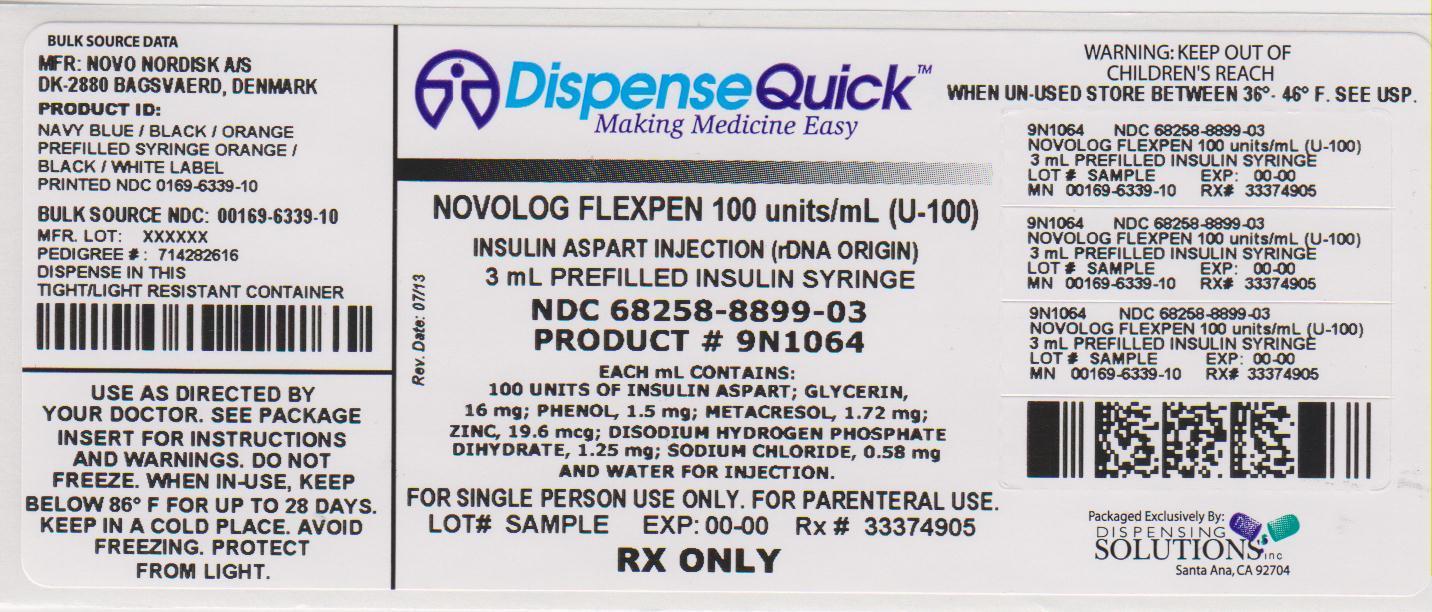
-
INGREDIENTS AND APPEARANCE
NOVOLOG
insulin aspart injection, solutionProduct Information Product Type HUMAN PRESCRIPTION DRUG Item Code (Source) NDC: 68258-8899(NDC:0169-6339) Route of Administration INTRAVENOUS, SUBCUTANEOUS Active Ingredient/Active Moiety Ingredient Name Basis of Strength Strength INSULIN ASPART (UNII: D933668QVX) (INSULIN ASPART - UNII:D933668QVX) INSULIN ASPART 100 [iU] in 1 mL Inactive Ingredients Ingredient Name Strength SODIUM PHOSPHATE, DIBASIC, DIHYDRATE (UNII: 94255I6E2T) 1.25 mg in 1 mL GLYCERIN (UNII: PDC6A3C0OX) 16 mg in 1 mL HYDROCHLORIC ACID (UNII: QTT17582CB) METACRESOL (UNII: GGO4Y809LO) 1.72 mg in 1 mL PHENOL (UNII: 339NCG44TV) 1.5 mg in 1 mL SODIUM CHLORIDE (UNII: 451W47IQ8X) 0.58 mg in 1 mL SODIUM HYDROXIDE (UNII: 55X04QC32I) ZINC (UNII: J41CSQ7QDS) 19.6 ug in 1 mL Packaging # Item Code Package Description Marketing Start Date Marketing End Date 1 NDC: 68258-8899-3 3 mL in 1 SYRINGE, PLASTIC Marketing Information Marketing Category Application Number or Monograph Citation Marketing Start Date Marketing End Date NDA NDA020986 01/22/2003 Labeler - Dispensing Solutions, Inc. (066070785) Registrant - PSS World Medical, Inc. (101822682) Establishment Name Address ID/FEI Business Operations Dispensing Solutions, Inc. 066070785 relabel(68258-8899) , repack(68258-8899)
Trademark Results [NovoLog]
Mark Image Registration | Serial | Company Trademark Application Date |
|---|---|
 NOVOLOG 75812138 2413874 Live/Registered |
Novo Nordisk A/S 1999-10-01 |
 NOVOLOG 75421022 2295132 Dead/Cancelled |
Novo Nordisk A/S 1998-01-21 |
© 2025 FDA.report
This site is not affiliated with or endorsed by the FDA.
